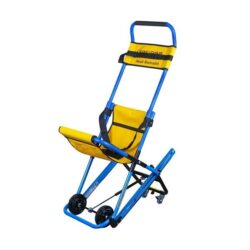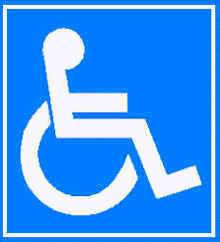Fire Safety for Special Needs Groups
People with Disabilities in the Home
If a fire occurs in your home, your chances of survival will depend on how quickly and safely you are able to get out. People with serious mobility difficulties should be encouraged to have their bedroom as close to a final exit door as practical, or to a relatively safe area.
People with disabilities should be aware of the special devices that are available such as smoke alarms with a vibrating pad or flashing light for those with a hearing impairment, smoke alarms with a strobe light outside the house to catch the attention of neighbours or passers-by, and emergency call or alarm systems for summoning help.
Means of Escape for Disabled People in Public Places
In public places the Regulatory Reform (Fire Safety) Order 2005 requires that the Responsible Person, when conducting a fire risk assessment and considering the means of escape from fire, should incorporate the recommendations of:-
- The British Standard BS 8300-2. “Design of an accessible and inclusive built environment. Buildings” to meet the needs of disabled people.
- The supplementary guide Fire Safety Risk Assessment: Means of Escape for Disabled People which can be downloaded at the Ministry of Housing, Communities and Local Government web site.
These are not a statutory documents but authoritative guidance on the design and management of buildings to enable the safe evacuation of people with disabilities. They include guidance for people with hearing and sight loss and information on how they apply to existing buildings. Copies of the British Standard may be obtained from the local library or you may have to purchase one from the British Standards Institute.
The following guidance should be read in conjunction with the British Standard BS 8300-2. The evacuation plan should only be devised by persons familiar with the location and the people involved.
- Disabled people, like everyone else, should always have available a safe means of escape in the event of fire.
- The nominated person in charge must, with the assistance of the Responsible Person, make the best practicable arrangements for ascertaining what areas are used by disabled people and must, in consultation with them, make adequate arrangements for their evacuation in the event of fire. These arrangements must be tested.
- A Personal Fire Evacuation Plan should be drawn up for every disabled person or group of disable people in the building. Regular building users who are disabled should receive a copy of a Personal Fire Evacuation Plan. If the building is one with a large number of visitors then simple relevant fire evacuation instructions should, so far as possible, be handed to disabled visitors by reception staff.
- So far as reasonably practicable, fire compartmentation in buildings used by disabled people and any other arrangements, must comply with BS 8300-2.
- Lifts must not be used in the event of fire unless they meet the special requirements of PD 7974-6 4″Application of fire safety engineering principles to fire safety design of buildings. Human factors. Life safety strategies. Occupant evacuation, behaviour and condition”.
- A sufficient number of people should be trained in advance in giving assistance to disabled people so that the necessary number would be present in the event of an emergency.
- Where necessary, arrangements must be made for the presence of the disabled person to be known to those who would give assistance. This could be done with an in-out tally at the entrance or by informing someone, providing the desk or office involved is permanently staffed during the day. In some cases, for example ensuring that deaf or blind people are helped out, a floor warden system may be more appropriate.
- The placing of restrictions on disabled people, requiring them to be accompanied at all times by potential helpers, should where possible be avoided. In buildings with good fire compartmentation it will usually be possible for people to work unaccompanied, provided there are adequate numbers of potential helpers elsewhere in the building. However, disabled people who would need assistance to leave in an emergency should not use buildings at times when insufficient helpers are present to assist evacuation (e.g. evenings and weekends). Also, if compartmentation in one area does not reach the standard of BS 8300-2 then it may be necessary to require that a disabled person only uses the area when sufficient numbers are immediately at hand. A disable person might use a particular floor for normal work and other places in the course of their work.
- Disabled people should not use any part of a building where it would be difficult for them, even with help, to escape in the event of fire. Use of basements by wheelchair users, where there is no basement level exit, is likely to be an example of this. Activities which might take place in such areas should be moved to different areas, so far as reasonably practicable, to avoid excluding disabled people.
- In the case of work above ground floor level by people who use a wheelchair or have difficulty with stairs, arrangements should be based on horizontal movement away from fire through fire-resisting doors to an area of refuge. BS 9999 indicates the layout requirements for this. Procedures could be based on the following principles:

- When the fire bell rings the disabled person asks assistance from anyone nearby to help in evacuation. The disabled person and helpers wait, without causing obstruction, in a place near the stairs until other occupants have gone down and the disabled person is then carried or helped downstairs. It may be necessary to provide one or more evac-chairs for this.
- If insufficient helpers are on hand the disabled person moves to the main stairwell, or another one if this had been considered by prior agreement with the emergency party to be more convenient, unless there are signs of smoke of fire in which case the stairwell furthest away from the fire is used and waits in the stairwell for assistance.
- The emergency party gathers and if the disabled person is known to be in the building they go to the pre-arranged staircase or, if that is in or very near the fire, to the alternative staircase and carry the disabled person down.
- A fire safety adviser can help in the application of this code to particular circumstances and should be consulted in cases where it appears that building modifications might be required to provide safe means of escape for disabled persons.
- Disabled people should include those temporarily disabled through injury.
Legal Overview
The Fire and Rescue Service’s role as enforcing authority is to ensure the means of escape in case of fire and associated fire safety measures provided for all people who may be in a building are both adequate and reasonable, taking into account the circumstances of each particular case.
Under current fire safety legislation it is the Responsible Person as defined by the Regulatory Reform (Fire Safety) Order 2005 to provide a fire safety risk assessment that includes an emergency evacuation plan for all people likely to be in the premises, including disabled people, and how that plan will be implemented. Such an evacuation plan should not rely upon the intervention of the Fire and Rescue Service to make it work. In the case of multi-occupancy buildings, responsibility may rest with a number of Responsible Persons for each occupying organisation and with the owners of the building. It is important that they co-operate and co-ordinate evacuation plans with each other. This could present a particular problem in multi-occupancy buildings when the different escape plans and strategies need to be co-ordinated from a central point.
The Equality Act 2010 does not make any change to these requirements: it underpins the above fire safety legislation in England and Wales by requiring that employers or organisations providing services to the public take responsibility for ensuring that all people, including disabled people, can leave the building they control safely in the event of a fire. Where an employer or a service provider does not make provision for the safe evacuation of disabled people from its premises, this may be viewed as discrimination. It may also constitute a failure to comply with the requirements of the fire safety legislation mentioned above.
Public bodies have an additional duty, called the Public Sector Equality Duty (PSED), which requires them to proactively promote the equality of disabled people and to do even more to ensure that disabled people do not face discrimination by not being provided with a safe evacuation plan from a building.
Further Guidance
Specialised advice may be obtained from:
Disabled Living Foundation
National Federation of the Blind of the UK
Disability Rights UK
Royal National Institute for the Blind
Action on Hearing Loss
Categories:Fire Safety Guides
April 1, 2011[Last updated: February 9, 2022]

Comments are closed here.